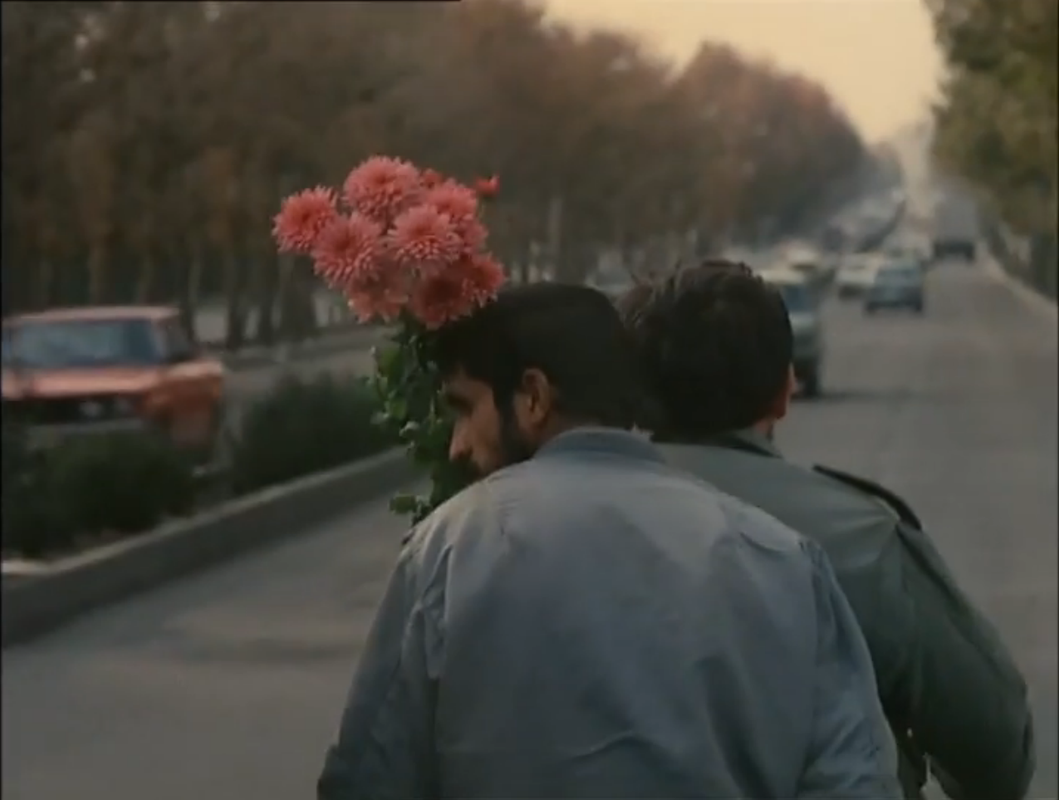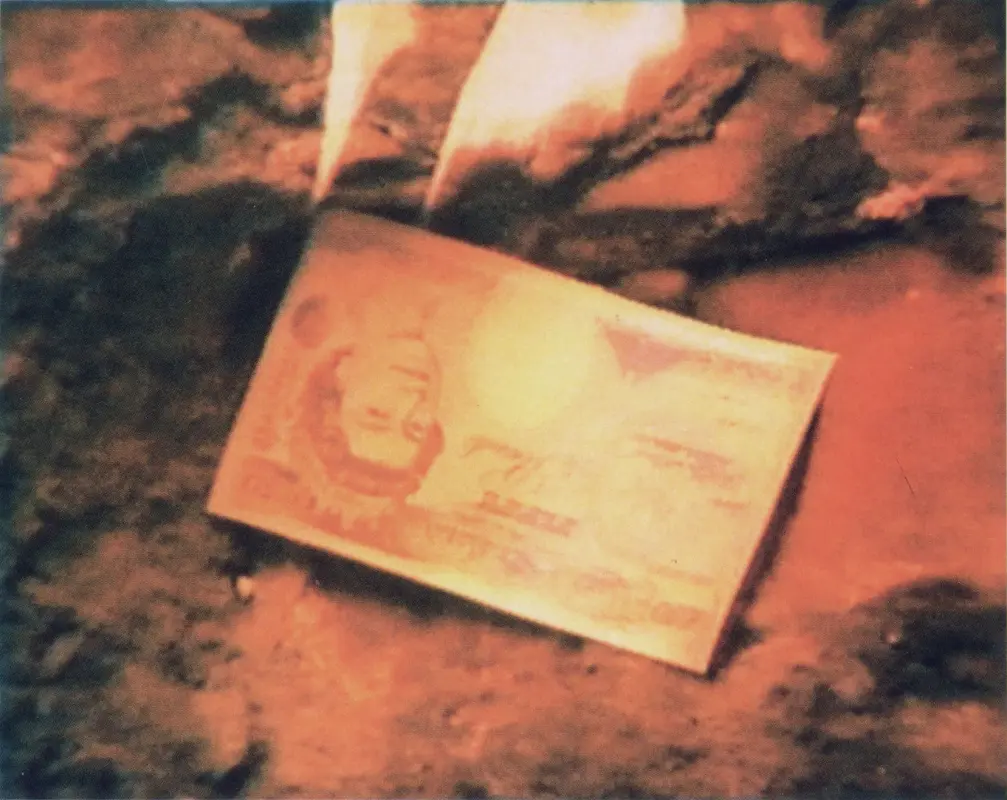“This future of yours Shelmerdine, when it's gonna begin? Today? Or, is it always tomorrow?”Orlando (Sally Potter, 1992)
Jan
24
Billy Zane's birthday

Orlando (Tilda Swinton) and Shelmerdine (Billy Zane) in intimate embrace. DPs: Aleksey Rodionov & Andrew Speller.
A [favourite] Billy Zane film for his birthday (1966).
– Orlando
As ordered by Queen Elizabeth I (Quentin Crisp), nobleman Orlando remains young and traverses exotic scenery, civilisations, time, and gender.
1990s
– Is there anything I can do for you? – You could make a film about my suffering.کلوزآپ ، نمای نزدیک [Klūzāp, nemā-ye nazdīk / Close-Up] (Abbas Kiarostami, 1990)
Jan
19

Hossain Sabzian on the back of a motorcycle on a busy tree-lined, four lane street. He's holding a large potted rose-red dahlia. DP: Ali Reza Zarrindast.
X2000 (François Ozon, 1998)
Jan
1
2000

A young, naked man holding a drink observes two men asleep in a sleeping bag on the floor. On the wall behind them the text “2000” spelled out with tinsel garlands. DP: Pierre Stoeber.
کلوزآپ ، نمای نزدیک [Klūzāp, nemā-ye nazdīk / Close-Up] (Abbas Kiarostami, 1990)
Nov
8

Hossain Sabzian as himself. He sits behind a low table holding various refreshments, presented by his host. DP: Ali Reza Zarrindast.
Goshogaoka [御所ケ丘] (Sharon Lockhart, 1998)
Nov
6
Play Basketball Day

Girls from the Moriya City Goshogaoka junior high school girl basketball team practising their blocking technique. Cibachrome print © Sharon Lockhart, 1997 (via).
Within the boundaries of Sharon Lockhart's static camera, girls from Goshogaoka junior high school practice basketball. In six uninterrupted 10 minute scenes, we see them warm up and train several typical moves, shots, and blocks. With the camera set in one position, some of the action happens off-screen, resulting in unrehearsed synchronised choreography.
“Prison is good for the good and bad for the wicked. It teaches the good a lesson but only makes the wicked worse.”کلوزآپ ، نمای نزدیک [Klūzāp, nemā-ye nazdīk / Close-Up] (Abbas Kiarostami, 1990)
Sep
8
Pardon Day

Hossain Sabzian riding passenger on a motorcycle holding a large potted rose-red dahlia. DP: Ali Reza Zarrindast.
کلوزآپ ، نمای نزدیک is visual narrative illustrating a crime. A cinephile, Hossain Sabzian, pretends to be filmmaker Mohsen Makhmalbaf and slowly extorts a family into believing to star in the director's next film.
– Hossain Sabzian
An article about the case intrigued director #Kiarostami so much that he decided to film the court case against Sabzian, and ask the accused, Makhmalbaf, and the Ahankhah family to reenact some of the events.
Cremaster 1 (Matthew Barney, 1996)
Sep
2
National Tailgating Day

Goodyear (Marti Domination) on the field, holding the two blimps from which she guides the chorus line. DP: Peter Strietmann.
American artist Matthew Barney dreamt of playing #AmericanFootball at Yale. His body, too short for the demanding game, became his personal battleground by way of torturous prosthetics and art performances testing its endurance. A fascination with biology – he considered medicine as his profession – is a recurring motif in his art. This will teach us that stage 1 of the cremaster cycle is the moment when the cremaster muscle – the muscle in the biological male responsible for the ascent and descent of the testes – is at its most ascended or undifferentiated state.
Cremaster 1, the second of the five part Cremaster cycle (1994—2002), is set at the Bronco Stadium in #Boise, #Idaho, Barney's hometown. Due of his personal connection with the place he was able to secure the stadium for a lush musical revue, complete with chorus girls and Goodyear #blimps. Instead of cheerleading yells and the crushing noise of chronic traumatic encephalopathy, we find ourselves quietly poised in an airship high above the field.
In each airship there is an ethereal woman (both played by gender-ambigious Marti Domination), arranging and rearranging grapes in intricate shapes, illustrating the development of the foetus from non-gendered to male. Below on luminous blue AstroTurf, the chorus line follows the same patterns.
Cremaster 1 is arguably the most accessible instalment of the cycle. Everyone, even if not familiar with the name Busby Berkeley, recognises the kaleidoscopic choreography. And those who have never watched a game of football in their lives, may pick up the subliminal patterns created by men dressed to overemphasise their already excessive masculinity.
“Your name is Rosetta. My name is Rosetta. You found a job. I found a job. You've got a friend. I've got a friend. You have a normal life. I have a normal life. You won't fall in a rut. I won't fall in a rut. Good night. Good night.”Rosetta (Jean-Pierre Dardenne + Luc Dardenne, 1999)
Aug
24
National Waffle Day

Émilie Dequenne as the titular Rosetta, eating a Gaufre de Liège (a “Liège waffle” made with brioche-based dough and pearl sugar) as part of daily normalcy. DP: Alain Marcoen.
The city of Liège in Belgium's Walloon region is grey. The air seems forever stained by the heavy mining that for years made its inhabitants rich and sick. Here lives Rosetta (Émilie Dequenne), a young woman trying to keep herself and her alcoholic mother afloat with measly jobs while saving up enough money so she can, finally, leave the trailer park she's forced to call home.
– Rosetta
Directors Jean-Pierre and Luc #Dardenne once described this film as a war movie. It's pained, like the voices from the trenches that still scar the Belgian landscape. The camera – Alain Marcoen's – close, as if were following the girl through a rifle's scope. And raw, like the open wounds left behind by the mining companies.
Sueños de hielo [Dreams of Ice] (Ignacio Agüero, 1994)
Jul
15
Arctic Sea Ice Day

Arctic ice in transit from Antarctica to Seville. DPs: José Luis Arredondo, Germán Liñero, Gastón Roca & Luis Roca.
